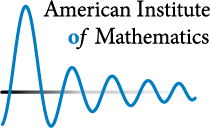4. Discrete geometry
-
Equi-isoclinic subspaces
Given $k$-dimensional linear subspaces $U,V\leq \mathbb{R}^d$, we say that $U,V$ are equi-isoclinic with angle $\alpha$ if every unit vector in $U$ projects down onto $V$ a vector of length $\alpha$.The case $k=1$ gives equiangular lines, which is known, using Ramsey Theory.Conjecture 4.1.
[Yufei Zhao] Let $N_\alpha^k(d)$ be the maximum number of $k$-dimensional subspaces of $\mathbb{R}^d$, every pair of which is equi-isoclinic with angle $\alpha$. Then
(1) $N_{\alpha}^k(d)=O_{\alpha,k}(d)$.
(2) $N_{\alpha}^k(d)=O_{k}(d)+o_{\alpha,k}(d)$.
$k=2$ generalizes "complex equiangular lines". Conjecture 1 is known for complex equiangular lines. -
Distinct distances and related problems
(1) is known with $|S|/3$ distinct distances, by double counting isosceles triangles.Conjecture 4.2.
[Cosmin Pohoata] (1) Let $S\subset\mathbb{R}^2$ with no three points collinear. Then $S$ determines at least $|S|/2$ distinct distances.
(2) Given $n$ points in $\mathbb{R}^2$ with no three collinear. Then one can remove $O(1)$-many points so that the number of isosceles triangles is at most $1.99\binom{n}{2}$.
(3) Given a set $S$ of $n$ points in $\mathbb{R}^2$ with no three collinear. Then $S$ determines $\Omega(n^2)$ perpendicular bisectors containing at most 1 point of $S$ each, unless $S$ is the vertices of a regular polygon together with its center. -
Kupitz conjecture in three dimensions
(Kupitz conjecture) Given $n$ points in $\mathbb{R}^2$, is there always a line through at least two points, such that the number of points on each side differ by $O(1)$?For Kupitz conjecture, if the optimal bound is $C$, then it is known that $2\leq C\leq O(\log\log n)$. For pseudoline arrangements, $C=\Theta(\log\log n)$.Problem 4.3.
[Jeck Lim] Given $n$ points in $\mathbb{R}^3$, is there always a plane through at least two points, such that the number of points on each side differ by $O(1)$?
For 3D, the same upper bound $O(\log\log n)$ follows by projection.
Cite this as: AimPL: High-dimensional phenomena in discrete analysis, available at http://aimpl.org/highdimdiscrete.
